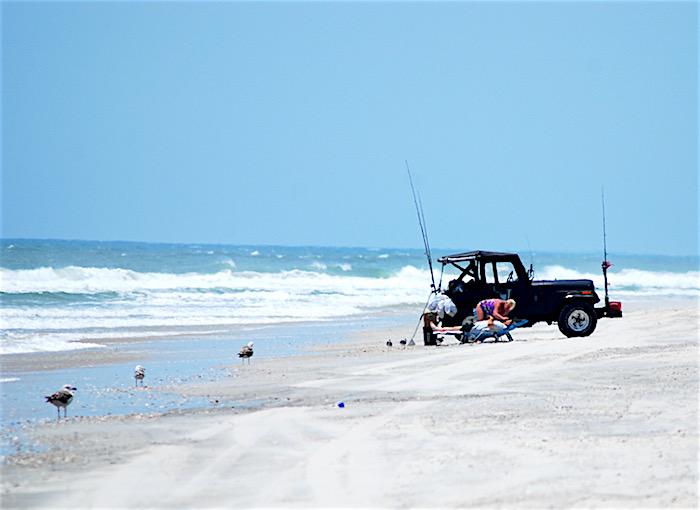
National Park Service officials have settled on an ORV management plan for Cape Lookout National Seashore/Kurt Repanshek
Off-road vehicles will require permits, have to follow designated routes, and face seasonal restrictions to some areas of the 56-mile-long Cape Lookout National Seashore under a management plan chosen by National Park Service officials.
“The plan allows public access while ensuring the resources of this national significant place are protected," said Seashore Superintendent Patrick Kenney while releasing the plan to the public on Friday.
The plan was required following a 2005 lawsuit that noted the Seashore had failed to development an ORV managment plan despite both an Executive Order and NPS policy on off-road vehicle use. A key aspect of the plan is to protect threatened and endangered species of seabirds, sea turtles, and vegetation.
While Park Service staff had proposed a limit of 5,500 ORV permits a year, the final plan pushes that number a bit to 6,200, a figure based "on the highest current level of ORV use looking at the number of ORVs delivered to each island from 2005 through 2015." After five years, ORV use would be examined and the annual limit could be changed.
Nontransferrable permits are to be made available on a first-come, first-served basis at a cost to be determined, though the Seashore could move to a lottery down the road to dispense permits. Before obtaining a permit, ORV users would have to attend a free "operator education certificate" that would be good for one year. Details on how the certificates would be issued have yet to be determined. The certificate could be revoked if the ORV operator violates park regulations or terms and conditions of the permit.
Under the management plan, night driving restrictions would be in place from May 1 through September 14 "to reduce potential impacts to turtles and birds." Additionally, night driving on the beach and ramps would not be allowed from 9 p.m. to 6 a.m., while the Back Route would be closed to drivers from 10 p.m. to 5 a.m.
The plan would make 45 of the Seashore's 56 miles open to ORV use from March 16 through April 30, and from September 15 through December 31. Seventy-five percent of the entire length of the Seashore would be open to ORV use from May 1 through Sepember 14.
"Routes within the Cape Lookout Village Historic District would be open to through vehicle traffic. Routes would also include an ORV corridor in front of the cabins at the dune line for ORVs to pass through," the plan says.
Shackleford Banks would not be open to ORV use, as it has been proposed for Wilderness designation and so is being managed as Wilderness, the staff noted.
Year-round pedestrian-only areas would include the following:
- Portsmouth Village, lighthouse beach, and Power Squadron Spit from approximately mile marker 46 to the end of the spit,
- Great Island and Long Point Cabins at the dune line, and all of Shackleford Banks.
Pedestrian-only areas would be expanded during the summer (defined as from May 1 through September 14) and would include the following:
- Long Point: On the ocean beach at the Long Point Cabin Camp for a day-use beach and a separate tent camping area for a total pedestrian-only area of about 0.50 miles, to be determined by beach profile.
- Great Island: On the ocean beach at the Great Island Cabin Camp for a day-use beach and a separate tent camping area for a total pedestrian-only area of 1.9 miles, to be determined by beach profile.
Vehicles banned from the Seashore include:
- High-performance sport-model and two-stroke ATV and UTVs (after a five-year grace period under alternatives B and D and a one-year grace period under alternative C)
- Vehicles with three wheels or less
- Tracked vehicles
- Farm vehicles
- Vehicles with two-stroke engines
- Combination vehicles (i.e., amphibious ATVs, amphibious aircraft, aircraft)
During the public comment period, some asked that "NPS should give preferred status to human visitors, and should not include restrictions on human use to benefit various natural resources. Other commenters suggested that some types of human uses should be given precedence over other types."
In rejecting those suggestions, the Seashore staff noted that the Park Service's primary mandate is to "preserve the Seashore’s natural and cultural resources unimpaired for the enjoyment of future generations. Furthermore, the courts have held that in the case of conflict, resource conservation must predominate."
Also rejected was a request that "off-leash" areas be designated for dog owners.
The next step in the process will involve signing the Record of Decision, which is anticipated to occur 30 days from the date of the release of the final plan. Once the Record of Decision is signed, the final regulations will be published in the Federal Register. Following the completion of the planning and regulation process, the NPS will implement the plan to continue to ensure visitors will be able to utilize the seashore while the resources are protected for future generations.



Add comment